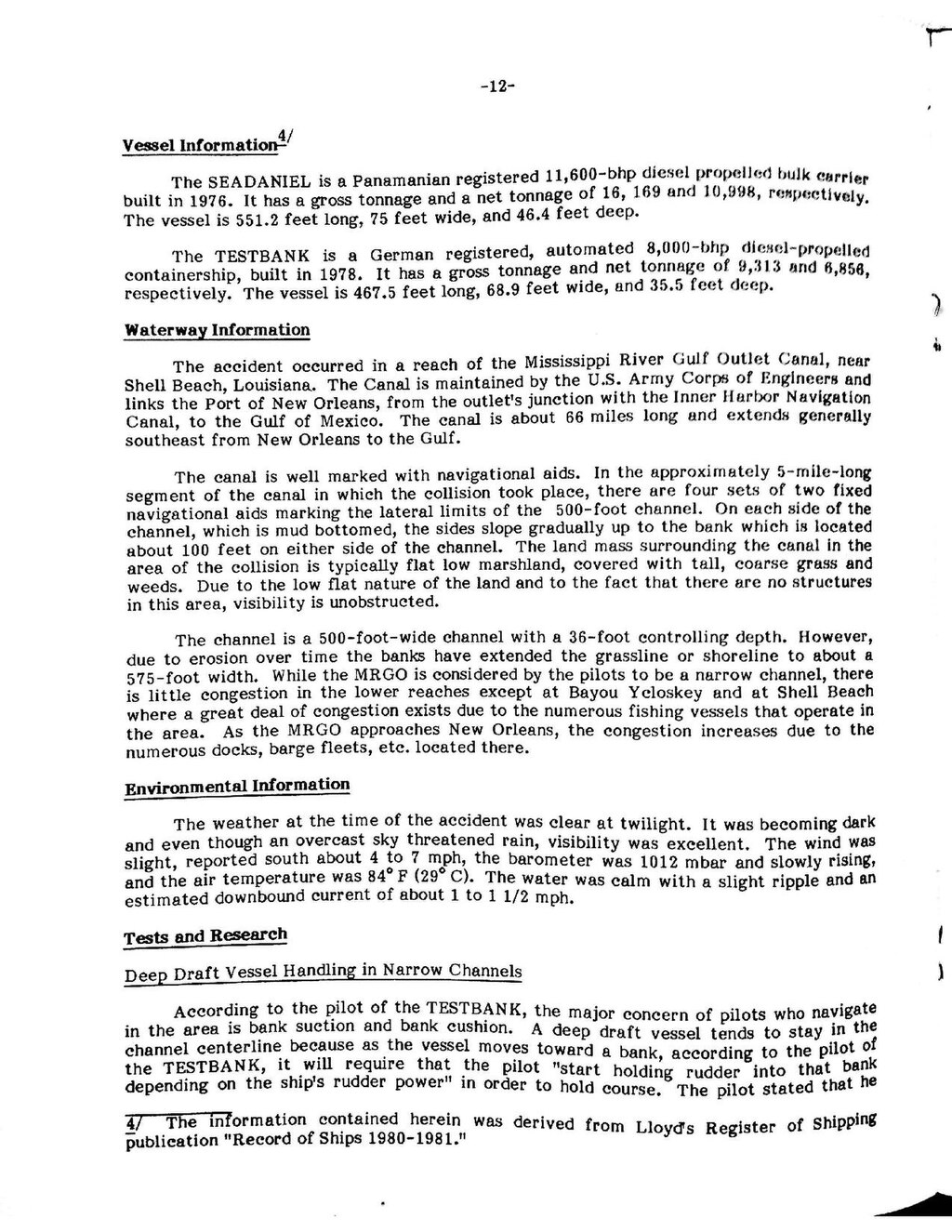Vessel Information[1]
The Seadaniel is a Panamanian registered 11,600-bhp diesel propelled bulk carrier built in 1976. It has a gross tonnage and a net tonnage of 16,169 and 10,998, respectively. The vessel is 551.2 feet long, 75 feet wide, and 46.4 feet deep.
The Testbank is a German registered, automated 8,000-bhp diesel-propelled containership, built in 1978. It has a gross tonnage and net tonnage of 9,313 and 6,856, respectively. The vessel is 467.5 feet long, 68.9 feet wide, 35.5 feet deep.
Waterway Information
The accident occurred in a reach of the Mississippi River Gulf Outlet Canal, near Shell Beach, Louisiana. The Canal is maintained by the U.S. Army Corps of Engineers and links the Port of New Orleans, from the outlet's junction with the Inner Harbor Navigation Canal, to the Gulf of Mexico. The canal is about 66 miles long and extends generally southeast from New Orleans to the Gulf.
The canal is well marked with navigational aids. In the approximately 5-mile-long segment of the canal in which the collision took place, there are four sets of two fixed navigational aids marking the lateral limits of the 500-foot channel. On each side of the channel, which is mud bottomed, the sides slope gradually up to the bank to which is located about 100 feet on either side of the channel. The land mass surrounding the canal in the area of the collision is typically flat low marshland, covered with tall, coarse grass and weeds. Due to the low flat nature of the land and to the fact that there are no structures in this area, visibility is unobstructed.
The channel is a 500-foot-wide channel with a 36-foot controlling depth. However, due to erosion over time the banks have extended the grassline or shoreline to about a 575-foot width. While the MRGO is considered by the pilots to be a narrow channel, there is a little congestion in the lower reached except at Bayou Ycloskey and at Shell Beach where a great deal of congestion exists due to the numerous fishing vessels that operate in the area. As the MRGO approaches New Orleans, the congestion increases due to the numerous docks, barge fleets, etc. located there.
Environmental Information
The weather at the time of the accident was clear at twilight. It was becoming dark and even though an overcast sky threatened rain, visibility was excellent. The wind was slight, reported south about 4 to 7 mph, the barometer was 1012 mbar and slowly rising, and the air temperature was 84ºF (29ºC). The water was calm with a slight ripple and an estimated downbound current of about 1 to 1 1/2 mph.
Tests and Research
Deep Draft Vessel Handling in Narrow Channels
According to the pilot of the Testbank, the major concern of pilots who navigate in the area is bank suction and bank cushion. A deep draft vessel tends to stay in the channel centerline because as the vessel moves toward a bank, according to the pilot of the Testbank, it will require that the pilot "start holding rudder into that bank depending on the ship's rudder power" in order to hold course. The pilot stated that he
- ↑ The information contained herein was derived from Lloyd's Register of Shipping publication "Record of Ships 1980-1981."
